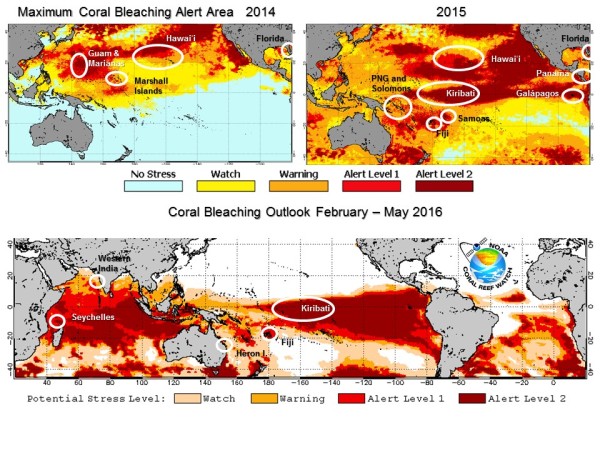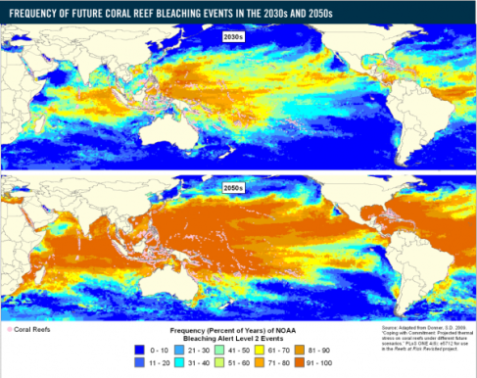Human Hothouse Spurs Longest Coral Die-Off on Record
23
February, 2016
The
big coral die-off began in the Western Pacific as a massive ocean
temperature spike built up during 2014. Back then, ocean heat
accumulation had hit a very high ramp. A vicious, century-and-a-half
long increase in atmospheric greenhouse gasses re-radiated greater
and greater portions of the sun’s energy hitting the Earth —
transferring the bulk (about 90 percent) to the world ocean system.
(A
report out today from AGU finds that the world is now experiencing
its longest coral die-off event on record. Image source: AGU.)
By
2015, as one of the strongest El Ninos on record began to extend its
influence across the globe, a broad region stretching from the
Western Pacific, through the Central Pacific and on into the Eastern
Pacific and Caribbean were all experiencing mass coral die-offs. Into
early 2016, die-off events again expanded taking in Australian waters
and sections of the Indian Ocean off East Africa and Western India.
After
20 months of ongoing coral mortality, we are now in the midst of the
longest coral die-off event on record — one of only four such
events that the world has ever experienced.
The
Fourth Major Coral Die-Off
Researchers
have long known that corals are sensitive to changes in ocean
temperature. Arise
in ocean water readings by as little as 1 degree Celsius above
average peaks over the period of a month can
be enough to set off a life-threatening condition called a coral
bleaching event. According
to a recent report in AGU:
The bleaching, or whitening, occurs when the corals expel the symbiotic algae that live in their tissues. Without the algae, corals lose a significant source of food and are more vulnerable to disease. In a severe bleaching event, large swaths of reef-building corals die. This causes reefs to erode, destroying fish habitat and exposing previously protected shorelines to the destructive force of ocean waves.
The
typical bleaching threshold for most corals tends to be in the range
of 29-30 degrees Celsius or about 84-86 degrees Fahrenheit over an
extended period.
And with the world ocean surface approaching a range near 1 C above
1880s averages, this threshold is hit more and more frequently —
putting corals at greater and greater risk.
(World
Resources Institute Published the above video in 2012 as a survey of,
then current, threats to global coral reef systems. By 2030, heating
of the world ocean system, ocean acidification and global warming
related dead zones will provide an extreme existential challenge to
the world’s beautiful and diverse coral reef systems.)
Prior
to the 1980s, widespread coral bleaching events were unheard of.
Though isolated events occurred, the world ocean system had not yet
warmed enough to put corals at major risk. However, by the 1980s
global ocean temperatures had begun to rise into ranges at which peak
ocean warming periods could put corals in the firing line for major,
globe-spanning die offs.
The
first such major, global coral die-off occurred during the, then
record, 1982-1983 El Nino.
At the time this event was unprecedented. And it held the dubious
standing as the only such event until the 1997-1998 Super El Nino set
off a similar, though longer-lasting mass die off. By the late 2000s,
global ocean temperatures had again risen — hitting marks high
enough to enable a weak 2010 El Nino to set off the third mass coral
de-off.
The
fourth mass die off began in 2014 prior to the most recent super El
Nino — which has only exaggerated and lengthened its impact. It is
now the longest lasting coral die-off ever recorded. And
researchers expect it to continue on through at least much of 2016
and possibly into 2017.
Corals
Entering a Period of Killing Heat
As
the oceans are predicted to continue warming over the next few
decades, corals are expected to come under ever-worsening stress. A
recent report by the World Resources Institute (WRI) found
that regions experiencing the current mass die-off were 70-90 percent
likely to experience similar events at a frequency of once every two
years by 2030. And a much larger region was expected to have a 50 to
70 percent risk of experiencing a bleaching event over a two year
time-frame.
(World
Resources Institute in 2012 found that mass coral bleaching and
related die-off would occur with extraordinary frequency post 2030.
Image source: The
World Resources Institute.)
By
the 2050s, under business as usual fossil fuel burning, WRI expects
that much of the world’s temperate and tropical oceans would
experience coral bleaching events bi-annually.
Taking
this stark prediction into account we find that the threat to corals
over the coming decades will eventually exceed El Nino periodicity
and become common during most ocean climate states. The current,
likely two year to 30 month, coral die off should serve as a warning
for the worse and more frequent hits to corals that will, sadly, be
stacking up over the coming decades. Eventually, mass coral die-offs
in the continually warming world ocean will become continuous and
ubiquitous unless the current trend somehow draws swiftly to a halt.
In
addition, given an expanding ocean acidification proceeding southward
from the poles and more and more widespread zones of ocean anoxia
(areas of water containing very little oxygen), what we are seeing is
that threats to coral health are rapidly multiplying due to
influences directly related to human-forced climate change.
Links:
Hat
Tip to TodaysGuestIs
Hat
Tip to TodaysGuestIs
Hat
Tip to DT Lange





No comments:
Post a Comment
Note: only a member of this blog may post a comment.